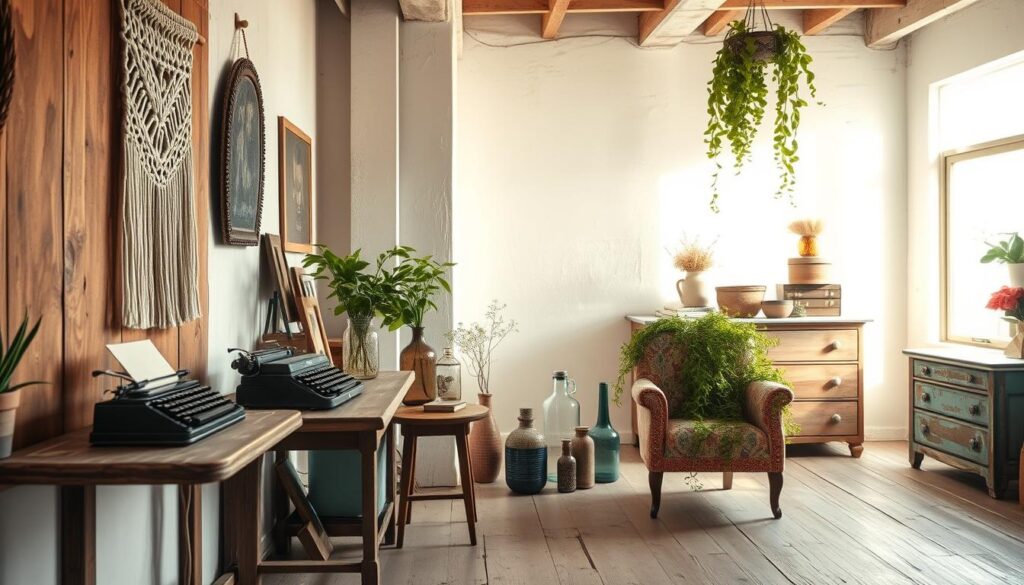Imagine turning a $8 lamp into a piece that rivals a $239 designer look. With a little creativity, secondhand treasures can become stunning additions to your home—without breaking the bank. This guide is your roadmap to unlocking the hidden potential of bargain items, blending DIY passion with budget-friendly elegance.
Across the United States, more people are discovering the joy of upcycling. A recent project transformed a $4.99 magazine rack into a high-end organizer using simple tools like spray paint and wood filler. These success stories prove that with the right techniques, even worn-out pieces can shine like custom décor.
Online platforms like eBay have turned this hobby into a profitable venture for many. Sellers are pairing smart upcycling with savvy marketing to create thriving side hustles. Best of all? You don’t need professional skills—just enthusiasm and our step-by-step strategies.
Key Takeaways
- Ordinary items become extraordinary with paint, hardware upgrades, and creative vision
- Save up to 90% compared to retail prices for similar designer looks
- Eco-friendly decorating reduces waste while refreshing your space
- Online marketplaces offer opportunities to turn projects into income
- Beginner-friendly techniques work with common tools and materials
Whether you’re refreshing your living room or building a decor business, we’ll show you how to spot diamond-in-the-rough pieces and transform them into conversation-starting showstoppers. Let’s dive into the art of creative reinvention!
Understanding Thrift Stores and Thrifting Culture
Long before vintage became trendy, community-driven resale spots laid the groundwork for today’s treasure-hunting craze. What began as humble efforts to support neighbors has blossomed into a cultural movement reshaping how we view pre-owned goods.
https://www.youtube.com/watch?v=a8AtbZn0VDM
History and Purpose of Thrift Stores
In 1897, Britain’s Wolverhampton Society for the Blind opened the first recorded charity shop. These early spaces sold donated items to fund social programs, creating a blueprint others would follow. By the 1920s, similar models reached U.S. cities, turning castoffs into community support.
Flipping wasn’t always about profit. Volunteers originally refreshed donated goods simply to maximize their value for charitable causes. A 1940s church bulletin notes: “Every repainted chair feeds three families for a week.”
How Thrifting Became a Lifestyle
The 2010s changed everything. As thrift culture exploded online, Gen Z transformed bargain hunting into both art form and side hustle. Recent data shows:
- Secondhand market growth tripled since 2016
- 63% of millennials prefer sustainable shopping
- Top resellers earn $5k/month updating vintage finds
Smart flippers now balance quality assessments with real-time price tracking apps. This shift from charity bins to curated resale proves one person’s discard truly becomes another’s designer-inspired centerpiece.
Mastering Thrift Store Flips for a Designer Home Decor Makeover
The secret to transforming forgotten pieces into luxury decor lies in strategic selection and planning. Successful transformations begin before you even touch a paintbrush—it starts with knowing what to look for and how to maximize your investment.
Steps to Evaluate Hidden Gems
Seasoned renovators recommend the 3-point checklist:
- Check for structural integrity (wobbly legs? Loose joints?)
- Research brands using your phone—some logos add 300% value
- Scan sold listings on eBay for similar products
Top seller Jamie Cortez shares: “A $12 side table sold for $189 because I recognized the mid-century manufacturer mark.” Always factor in repair costs—if refinishing eats 40% of potential profit, walk away.
Crafting Your Success Blueprint
Build a spreadsheet tracking:
- Maximum purchase price (aim for 25% of resale value)
- Local market preferences (farmhouse vs. modern?)
- Time investments per project
Negotiation skills boost margins significantly. If an item has minor flaws, politely ask for 15-20% off—most locations expect haggling. Pair this approach with free design apps that visualize makeovers, helping you buy with confidence.
Start small: choose 5-7 products monthly to build skills without overwhelm. As your eye for quality sharpens, gradually scale operations. Remember, 73% of top sellers began as weekend warriors before turning their side hustle into steady income.
Essential Tips to Identify and Select Profitable Thrift Store Finds
The difference between a bargain and a goldmine lies in your selection process. Seasoned hunters know that spotting hidden potential requires equal parts observation and research. Let’s explore how to separate everyday castoffs from pieces worth your investment.

Recognizing Quality and Value
Look for these signs of hidden worth:
- Sturdy construction: Solid wood joints, intact seams, and smooth-operating hardware
- Brand markings: Faded logos or serial numbers indicating premium manufacturers
- Material quality: Heavy ceramics, thick glass, or tightly woven fabrics
One seller doubled her profits by noticing a Danish furniture stamp under peeling paint. Always carry a flashlight to inspect finishes and check for structural repairs. Minor scratches often buff out, but warped surfaces rarely justify the effort.
Conducting Market Research for Smart Flipping
Tools like ZIK Analytics reveal what’s trending across platforms. Compare completed sales for similar products—a vintage lamp base might sell for $45 as-is or $120 with updated wiring. Top performers track:
- Seasonal demand spikes (holiday décor moves fastest November-December)
- Average selling price fluctuations by region
- Photography styles that attract premium bids
“Clean, well-lit photos increase bids by 30%,” notes resale coach Marisa Teng. Pair crisp images with precise measurements and material details. Remember: timeless mid-century pieces often outperform fleeting trends in long-term profit potential.
DIY Upcycling Techniques for Stunning Home Decor
Your next statement piece could be hiding in plain sight at a local resale spot. With simple techniques, ordinary items become custom décor that rivals boutique product lines. Let’s explore how to turn overlooked finds into head-turning accents.

Creative DIY Projects to Transform Finds
Try these crowd-pleasing transformations:
- Ceramic vases: Dip in metallic paint for modern texture
- Outdated frames: Add molding paste for 3D art displays
- Wooden drawer units: Line with removable wallpaper
One maker turned a chipped serving tray into a $85 bathroom organizer using peel-and-stick tiles. As designer Martha Stewart advises: “Good bones matter more than surface flaws.” Focus on structural integrity first—sanding and priming often reveal hidden potential.
Tools and Materials You’ll Need for Upcycling
Build your toolkit with these essentials:
- Multi-surface paints ($3-$8 at craft stores)
- Reusable sanding blocks
- Quick-dry adhesives
- Protective sealants
Many people source supplies from dollar stores or holiday-themed accents during sales. Document each project’s progress—before-and-after photos boost selling potential by 40% according to Etsy research. Pair transformations with trend-aware descriptions like “coastal cottage chic” or “industrial minimalist.”
These methods let anyone create gallery-worthy pieces while building a side hustle. Remember: Unique finishes and smart shipping strategies help your content stand out online. Start small, experiment boldly, and watch ordinary objects become extraordinary showpieces.
Using Online Platforms and Social Media for Flipping Success
Your carefully restored pieces deserve an audience that appreciates their value. Online marketplaces and social networks have become powerful tools for connecting creators with buyers across the United States. Over 73% of upcyclers now sell through digital channels, according to recent e-commerce reports.
Maximizing eBay and Alternative Marketplaces
eBay remains the top choice for store finds turned premium décor. Listings with “before-and-after” photos earn 22% more bids than standard posts. Take advantage of these features:
- Promoted Listings: Boost visibility for $2-$5/day
- Best Offer option: Encourage negotiation
- Terapeak research tool: Track pricing trends
| Platform | Fees | Audience | Best For |
|---|---|---|---|
| eBay | 12.9% | National | Vintage furniture |
| Etsy | 6.5% | Craft lovers | Artistic upcycles |
| Facebook Marketplace | 0% | Local buyers | Large items |
Promoting Your Flips on Social Media
Instagram Reels showcasing transformations get 3x more engagement than static posts. Use your phone to capture:
- Detail shots under natural light
- 360-degree videos demonstrating functionality
- Styled room scenes showing the piece in use
Top sellers pair hashtags like #UpcycledLuxury with location tags to attract local buyers. One creator gained 8,000 followers by sharing time-lapse restoration videos set to trending audio clips.
Reduce shipping costs by reusing packaging from store finds and offering local pickup. Free design apps like Canva help create professional listings in minutes. As one full-time upcycler notes: “Your online presence is your storefront—make it irresistible.”
Budget-Friendly Makeovers: Thrift Finds Turned Designer Decor
Style-conscious decorators know luxury looks don’t demand luxury prices. By blending eras and textures, secondhand treasures become bespoke accents that fool even design-savvy eyes. A $3 brass lamp base paired with a modern shade creates instant sophistication—proof that vision trumps budget.
Curating Cohesive Eclecticism
Mix mid-century chairs with sleek acrylic tables for dynamic contrast. Repaint dated wooden shelves in matte black, then display minimalist ceramics for gallery-wall appeal. “Layering eras adds depth,” says interior stylist Lena Torres. Her secret? Use 70% neutral base pieces and 30% bold vintage statements.
One entrepreneur turned $15 worth of hardcover books into a floating shelf display that sold for $220. Others stack mismatched trays as chic side tables or frame textile scraps as wall art. These projects prove ordinary things become extraordinary with intentional styling.
Smart sellers track emerging market trends through design books and social media. For example, rattan pieces surged 140% in searches after a popular home decor book featured them. Building a business in this niche means spotting these shifts early.
Bulk buying strategies help too. Negotiate discounts on multiple items needing similar upgrades—like six dining chairs needing reupholstering. This approach cuts material costs by 30-50% per project. As resale pro Marco Jensen advises: “Treat each find like a puzzle piece—it might complete someone’s dream room.”
Conclusion
Hidden treasures await in unexpected places for those willing to look beyond surface flaws. This creative journey blends smart sourcing with artistic vision, letting you craft high-end décor while keeping budgets lean. With secondhand markets thriving across the United States, there’s never been a better time to start.
Mastering this craft requires three essentials: spotting quality construction, applying transformative techniques, and showcasing results effectively. As experts like Marisa Teng emphasize, crisp photography and trend-aware descriptions can turn $15 projects into $200 sales. Remember—73% of successful sellers began with just a few test pieces before scaling up.
Your next goldmine might be a chipped vase or weathered side table waiting for fresh purpose. Digital tools now make it simple to research trends, price competitively, and connect with eager buyers nationwide. Why wait? Grab your sanding block, fire up your selling apps, and let those creative juices flow.
Every upcycled piece tells a story of renewal—both for your space and your wallet. Start small, learn continuously, and watch ordinary objects become extraordinary assets. Ready to redefine luxury living? Your local resale spot’s hidden gems are calling.

